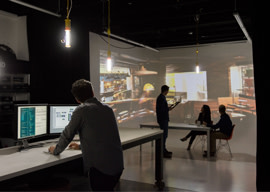
The financial services industry is having a transformational moment, seizing technology to steer increasingly toward rich, user-centered experiences and away from the often frustrating and opaque customer interactions of the past. Tackling challenges that result from such a tremendous change requires methods that allow an organization to bring customer experiences to market with speed and confidence. Through our work with leading companies in this and other fields, Continuum has developed a means for creating valuable software that is both efficient and highly relevant to users: agile design and development.
Some background. Two of the most sweeping changes to the way innovative, dynamic businesses operate in the past 20 years are the rise of design and agile development. Facebook, Google, and Amazon have grown their art and design staffs by 65% in 2016 alone, while IBM has increased its designer:developer ratio nine times in the past five years, and has plans to train its entire workforce in design. Likewise, 94% of organizations surveyed by VersionOne practice agile, with 72% of those adopting in the past five years.
Those firms that incorporate a clear, repeatable system-one joining designers and agile developers in a cohesive process-create a feedback loop that makes all parties more effective.
But these fundamental strategic and operational shifts, while valuable on their own, become even more powerful when integrated. Companies focusing independently on both design and agile development are reaping additive benefits, but those firms that incorporate a clear, repeatable system—one joining designers and agile developers in a cohesive process—create a feedback loop that makes all parties more effective. This multiplicative effect leads to many outsize benefits, including faster prototypes, better design, and increased customer value.
Design in business context focuses on understanding customers' needs and envisioning future products and services to address those needs. Designers continually test and refine ideas with users to arrive at the most relevant future state. Good design addresses those needs in a human-centered way, striving to create a future state that adapts to the customer.
Agile software development is driven by principles and values intended to focus organizations on delivering better software at a faster pace and to continue improving it over its lifespan. Agile values individuals and interactions, working software, customer collaboration, and responding to change. In practice, agile teams have defined roles and processes intended to develop an understanding of the way people use software in order to deliver a superlative product quickly and well.
Design and agile development are philosophically aligned and structurally compatible. Both place the user at the center, focus on getting user reactions to stimuli often, and depend on iteration to get progressively closer to the ideal. While design seeks areas of highest user value, agile development ensures that that value is represented in the best possible way. Combining the two into an agile design and development process ensures that both roles enhance each another and nothing is lost in translation.
This method works across industries. In addition to financial services, Continuum has successfully used agile design and development to help leading healthcare organizations achieve discrete objectives in the short term. Furthermore, this experience helps companies build repeatable structures that can identify and define areas of significant opportunity, design ideal solutions, and test and scale those offerings quickly while using resources efficiently.
In the design process, when a team is still in the discovery stage, it's important to involve people from the development team, such as scrum masters, product owners, and software developers. This ensures that the people building the software have insight into how the requirements were created and can influence those requirements to reflect a more feasible end state. It also enables people on the development side to observe users responding to prototypes and stimuli while the software is still in an early design stage. This helps them to identify with, and think like, users.
Design and agile development are philosophically aligned and structurally compatible.
Upon reaching the development stage, designers should still be involved, even attending daily standups and other team meetings. Their role is to continue to refine the design as it's being developed, so that neither design nor development work too far without input from the other. Designers represent the overall design and the choices made while simultaneously reacting to and accommodating developer concerns. Developers are responsible for raising feasibility issues and identifying problems, and they should work with designers to solve or work around these issues.
This process is successful when roles and responsibilities are unambiguous and the team works toward the shared goal of delivering as much user value as fast as possible. Teams should be tightly integrated, with representatives from design and development checking in on a daily basis. When someone raises a concern, the team's mindset should be one of searching for "and" solutions, not "or" solutions. Empowering individuals to look for creative ways around problems that accomplish shared objectives is key.
Conversely, the process is unsuccessful when one group has too much control. The intent is to distribute power into the hands of people best equipped to make the decisions and to tackle challenges in ways that satisfy both sides. For example, designers with too much control may be tempted to ignore feasibility concerns from developers and push them to embody the design exactly as conceived. Or developers with too much control may dispense with good design in order to deliver working software more quickly. In reality, the optimal solution is somewhere in between. Both sides must adapt to the interests of the other.
Properly integrating these two functions into an agile design and development process will help your organization deeply understand customers, create solutions that address their needs, and iterate those solutions in the market on the path to a full-scale offering that delivers maximum customer value as quickly as possible. This system amplifies the knowledge and skills of your people to transition smoothly from strategic challenges to functional offerings in the market. Ones that will create loyal customers and make your organization more relevant and responsive than competitors. In a future post, we'll explain in more detail how we've defined capabilities, roles, and interactions between them to make agile design and development work to full effect.




